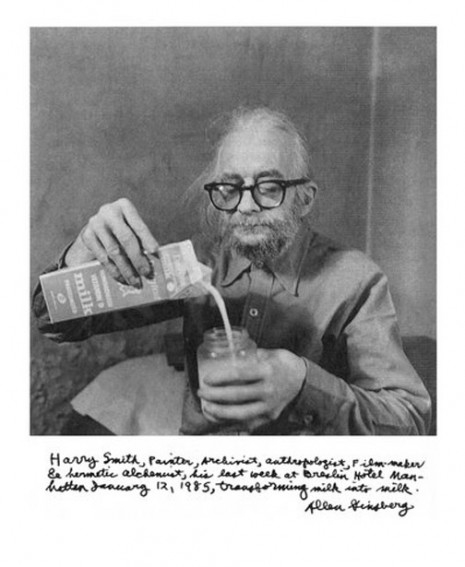
Artist, alchemical filmmaker, musical archeologist and avant garde shaman, Harry Smith’s obsessive interests made him an influential, yet not widely known, figure of 20th century Beat culture and beyond. If Smith was only responsible for preserving the folk and blues musical traditions of early America in his Anthology of American Folk Music set from 1952, we would have him to thank for providing a way forward for a young Bob Dylan and the whole of the 60s/70s folk scene.
But Smith was far more than that, he was a filmmaker of astonishing originality, making stop motion animations influenced by 19th advertising art and the elaborate Middle Ages alchemical paintings of Robert Fludd. When I first saw VHS dubs of Smith’s films in the 1980s, I was impressed of course, but as I later learned, in actual fact what I had seen was only a part of what Smith had intended. He made his films as magic lanterns, with several projectors running at once and spinning lamps complementing the central image. When I saw his restored masterpiece No. 18: Mahagonny at the Getty Center in Los Angeles a few years back, it struck me how difficult it must have been to sync up four projectors at once (and the musical accompaniment, a recording of Kurt Weil and Bertolt Brecht’s Rise and Fall of the City of Mahagonny opera).
The restored version of Smith’s celluloid tetraptych was a marvel to behold, with all of the four images now perfectly in time to one another, and looking like a great psychedelic kaleidoscope of imagery taken around New York City, in particular the Chelsea Hotel and its bohemian denizens. Patti Smith, Allen Ginsberg and the Jefferson Airplane’s Marty Balin all make cameo appearances. Seen, digitally restored and as Smith had intended, it was simply breath taking.
Apparently Smith never met a drug he didn’t like and would take any pill, drink any drink, smoke any joint, or snort any powder offered him and he was not at all averse to huffing gasoline, it’s been said, when that’s all that was around. For long periods of time he lived off the kindness of others and borrowed lots of money he had no intention of ever repaying. Yet Smith himself was said to be generous to a fault. Strange anecdotes about Harry Smith abound, many of them collected in two books about him American Magus: Harry Smith (edited by Paola Igliori) and Think of the Self Speaking (edited by Rani Singh, who is Smith’s archivist). My favorite story about Smith is how, if he’d find a pair of glasses, try them on and could see out of them better than the ones he was wearing, he’d toss the old pair in the garbage. Smith also claimed that Aleister Crowley was his father. All in all, you could say he was a colorful guy.

I am reminded of Harry Smith every day. I have one of the original Tree of Life prints that Smith made in the 1950s and gave as a gift to Allen Ginsberg. It’s still in the original brass frame that Ginsberg put it in. His handwriting is on the back in pencil along with a sticker from the Whitney. It’s in our dining room now.
In the last couple of years, New York-based artist M Henry Jones, who worked with Smith and continues to project Smith’s work as it was intended to be seen (click here for a short interview with Jones and some footage of one of his special Smith screenings. It’s really interesting to see, trust me) has put up a few fascinating videos of Smith being interviewed: